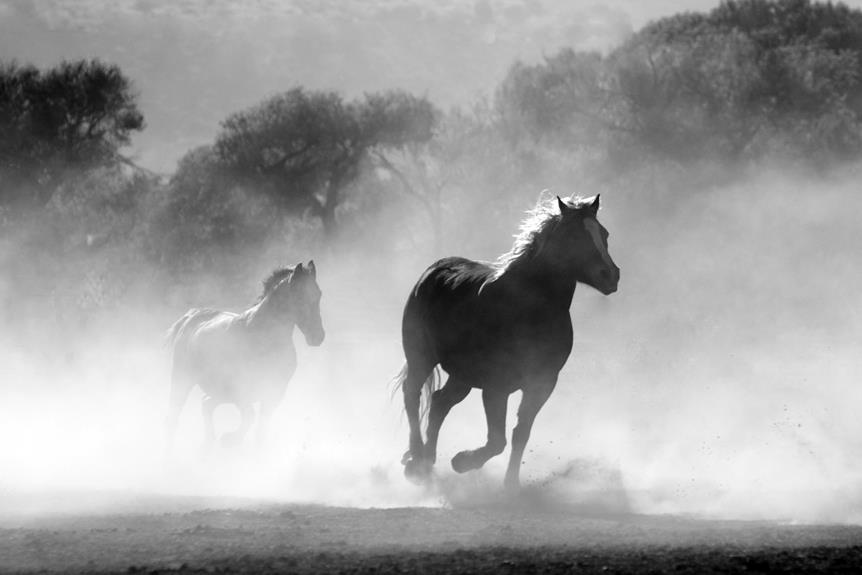Imagine you are a rider, eagerly preparing for a horseback adventure. As you approach the stables, you catch sight of a towering mountain in the distance. You can't help but wonder: just like that mountain, is there a weight limit that should not be surpassed when riding a horse?
Well, my friend, in this discussion, we will explore the importance of weight limits for horseback riding and discover how it affects both the rider's safety and the horse's well-being.
So, saddle up and let's embark on this journey together, uncovering the factors that determine the ideal weight range and the best horse breeds for different riders.
But before we delve into these details, let's first understand why weight limits matter in the world of horseback riding.
Key Takeaways
- Weight limits are important for protecting horses from injuries and discomfort caused by excessive weight.
- Determining a safe weight range for horseback riding involves considering the horse's breed, size, and fitness level, as well as balancing the rider's weight.
- Factors such as the horse's physical condition, breed, and the rider's weight affect the horse's carrying capacity.
- Choosing the right horse breed based on the rider's weight, age, and purpose ensures a safe and enjoyable riding experience.
Importance of Weight Limits
Understanding the importance of weight limits is vital for ensuring the safety and well-being of both riders and horses during horseback riding. Weight limits are put in place to protect the horses from potential injuries caused by excessive weight. When a rider exceeds the weight limit, it can lead to discomfort, stress, and even physical strain on the horse. This can result in various health issues for the animal, including back problems, muscle strains, and even lameness.
Moreover, an overweight rider can also lose balance and stability, increasing the risk of accidents and falls during the ride.
Horseback riding is a partnership between the rider and the horse, and it's crucial to respect the weight limits set by equestrian centers and horse riding operators. These weight limits aren't discriminatory but rather a necessary measure to ensure the safety and well-being of everyone involved. By adhering to the weight limits, riders can contribute to maintaining a safe riding environment for themselves and the horses. It also allows the horses to perform at their best, ensuring a positive and enjoyable riding experience for everyone.
Determining a Safe Weight Range
Respecting weight limits is crucial for ensuring the safety and well-being of both riders and horses. Now let's focus on determining a safe weight range for horseback riding. Here are three key factors to consider when determining the weight a horse can safely carry:
- Horse breed: Different horse breeds have different sizes and physical capabilities. Larger horse breeds, such as draft horses, are generally better equipped to carry heavier riders compared to smaller horse breeds, like ponies or Arabians. It's important to match the rider's weight with a suitable horse breed.
- Horse's size and fitness: Even within the same breed, horses can vary in size and fitness level. A well-conditioned and muscular horse will be better able to carry a heavier rider compared to a smaller or out-of-shape horse. Before riding, assess the horse's physical condition to ensure it can comfortably carry the intended weight.
- Rider's weight: A heavy rider can put excessive strain on a horse's back and legs, potentially causing discomfort or even injury. To determine a safe weight range, consider the rider's weight in relation to the horse's size and fitness. It's important to find a balance where the horse can comfortably carry the rider without compromising its well-being.
Factors Affecting a Horse's Carrying Capacity
Factors that can affect a horse's carrying capacity include its physical condition, breed, and the rider's weight.
A horse's physical condition plays a significant role in determining how much weight it can comfortably carry. Horses that are in good shape with strong muscles and healthy joints are better equipped to handle heavier loads. On the other hand, horses that are out of shape or have pre-existing health issues may not be strong enough to carry heavy riders.
The breed of the horse also plays a role in its carrying capacity. Different horse breeds have different builds and capacities for carrying weight. For example, larger and stockier breeds like draft horses or some warmbloods are generally better suited for carrying heavier riders. Thoroughbreds and smaller breeds, on the other hand, may have a lower carrying capacity due to their lighter build.
The weight of the rider is another important factor to consider. Heavier riders put more stress on the horse's back and joints, which can lead to discomfort or even injury. It's crucial for riders to be mindful of their own body weight and choose horses that are suitable for their size. Proper mounting and dismounting techniques are also essential to prevent unnecessary strain on the horse's back.
Best Horse Breeds for Different Riders
If you're looking for the best horse breed for your specific riding needs, consider the following options:
- Percherons, Drafts, Clydesdales, and Friesians: These breeds are better suited for heavier riders due to their strong bones and medium-length backs. They can handle the total weight of a heavier rider and provide a stable and comfortable ride. If you fall into this category, these draft horses might be the perfect choice for you.
- Morgan horses, Friesian horses, Icelandic horses, Tennessee Walking Horses, and Connemara Ponies: These breeds are recommended for beginners and lighter riders. They offer a comfortable and enjoyable riding experience, making them great options for those new to horse riding. Their smaller size and gentle nature make them ideal for riders who are just starting out.
- Height-to-Weight Proportion Chart: It's crucial to assess safety and comfort when choosing a horse breed. Using the Height-to-Weight Proportion Chart can help determine if you're allowed to ride a particular horse. Additionally, the ranch's discretion is the final authority on riding eligibility, ensuring overall safety.
Considerations for Rider's Age and Horse's Purpose
When choosing a horse, it is important to consider the rider's age and experience level as well as the horse's purpose. These factors play a crucial role in ensuring a safe and enjoyable horseback riding experience.
| Rider's Age | Horse's Purpose |
|---|---|
| Young children | Gentle and well-trained horses suited for beginners |
| Teenagers and adults | Horses with varying temperaments and training levels based on skill and experience |
| Older riders | Horses with a smooth gait and comfortable build for stability and reduced strain |
For young children, it is essential to select horses that are gentle and well-trained, providing a safe and confidence-building environment. Teenagers and adults can choose horses based on their skill level and experience, opting for more spirited horses if they have the expertise to handle them.
For older riders, it is crucial to prioritize horses with a smooth gait and a comfortable build. This ensures stability and reduces strain on the rider's body, enabling them to enjoy horseback riding for longer periods without discomfort.
Considerations for the horse's purpose are also important. Different horses are bred and trained for various activities such as trail riding, jumping, dressage, or racing. Matching the horse's purpose with the rider's needs ensures a harmonious partnership and a more fulfilling riding experience. So, remember to take into account the rider's age and the horse's purpose when choosing the right horse for horseback riding.
Frequently Asked Questions
Can I Ride a Horse at 300 Pounds?
Yes, you can ride a horse at 300 pounds. However, it's important to consider weight distribution, fitness requirements, horse breed suitability, saddle options, riding techniques, and potential health risks.
Can You Be Too Heavy for Horse Riding?
Yes, you can be too heavy for horse riding. It's important to choose the right horse for your weight and size. Safety precautions, proper techniques, and training programs can help ensure a positive experience.
Can Someone Over 200 Lbs Ride a Horse?
Yes, someone over 200 lbs can ride a horse. Riding considerations include weight distribution, horse training, and rider fitness. It's important to use appropriate horseback riding equipment and consider weight loss tips if desired.
Can a Horse Carry a 400 Pound Person?
Yes, a horse can carry a 400-pound person, but there are health risks and proper weight distribution to consider. Training requirements, equipment considerations, and the impact on the horse's physical well-being are crucial. For individuals with higher weights, alternative activities may be recommended.
Conclusion
So, when it comes to horseback riding, it's crucial to respect weight limits for the safety and well-being of both the rider and the horse. Exceeding these limits can cause discomfort and potential injuries for the horse, as well as increase the risk of falls and injuries for the rider.
By matching riders to horses based on their weight and experience, we can ensure a safe and enjoyable riding experience for everyone involved.



0 Comments